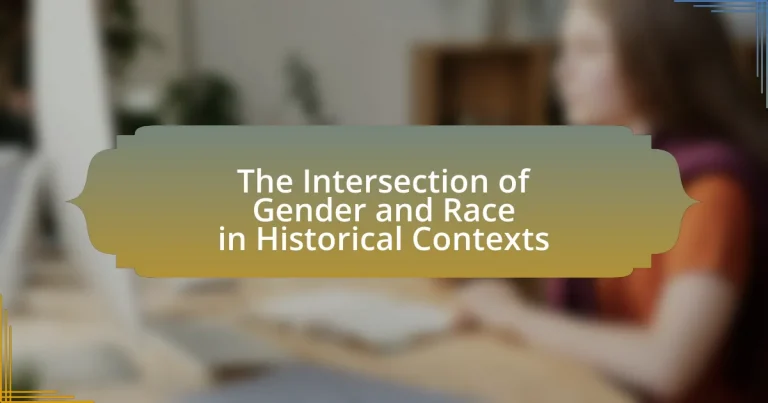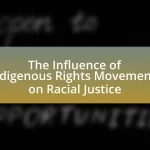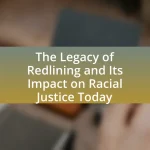The article examines the intersection of gender and race in historical contexts, highlighting how these social categories interact to shape individual experiences and societal structures. It discusses the unique challenges faced by women of color, particularly African American women, throughout history, including during slavery and the suffrage movement. Key historical events, such as the Seneca Falls Convention and the Civil Rights Movement, are analyzed to illustrate the complexities of race and gender dynamics. The article also explores contemporary issues, critiques of feminist theories, and the importance of intersectionality in social justice movements, emphasizing the need for inclusive policies that address the specific needs of marginalized groups.
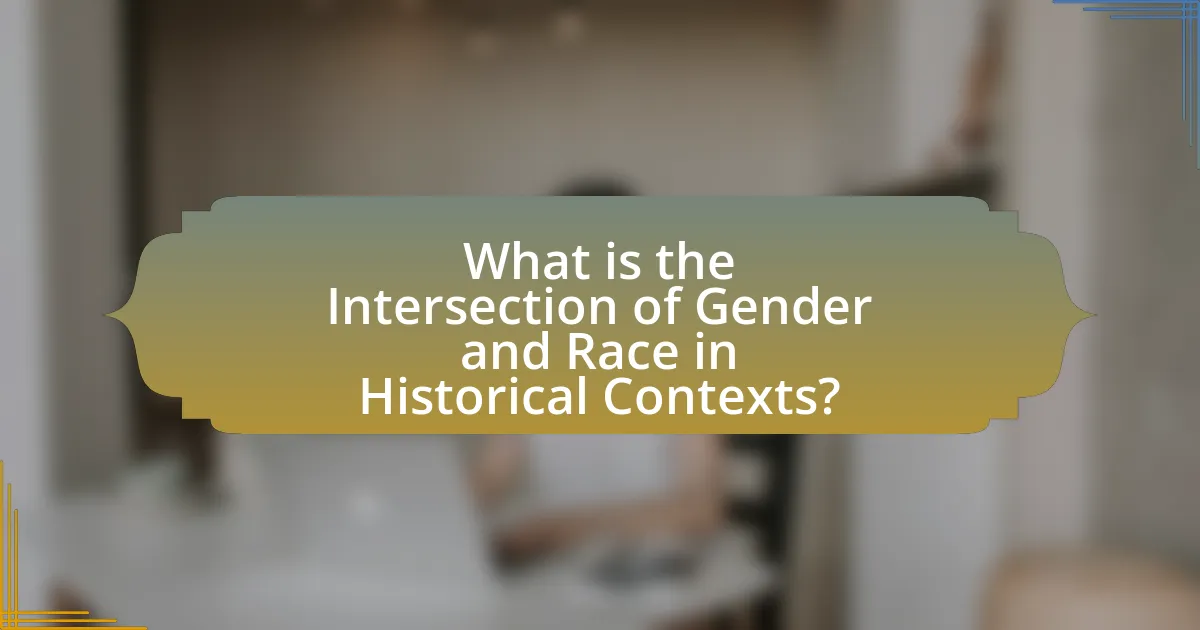
What is the Intersection of Gender and Race in Historical Contexts?
The intersection of gender and race in historical contexts refers to the ways in which these two social categories interact to shape individual experiences and societal structures. Historically, women of color have faced unique challenges that differ from those encountered by white women or men of any race, as evidenced by the experiences of African American women during slavery, who endured both racial oppression and gender-based violence. This dual oppression is documented in works such as “Ain’t I a Woman?” by bell hooks, which explores how race and gender intersect to create distinct social realities. Additionally, the suffrage movement in the United States illustrates this intersection, where white women sought voting rights while often excluding women of color from the movement, highlighting the complexities of race and gender dynamics.
How have gender and race intersected throughout history?
Gender and race have intersected throughout history by shaping social hierarchies and influencing individual experiences based on both identity factors. For instance, during the transatlantic slave trade, enslaved African women faced unique forms of oppression that combined racial discrimination with gender-based violence, leading to their exploitation in both labor and sexual contexts. Additionally, the suffrage movement in the early 20th century highlighted the intersectionality of race and gender, as white women often marginalized women of color in their fight for voting rights, demonstrating how racial dynamics influenced gender struggles. Historical events, such as the Civil Rights Movement, further illustrated this intersection, as Black women like Rosa Parks and Angela Davis played crucial roles, yet their contributions were often overlooked in favor of their male counterparts. These examples underscore that the intersection of gender and race has consistently shaped societal structures and individual experiences throughout history.
What historical events highlight the intersection of gender and race?
Key historical events that highlight the intersection of gender and race include the Seneca Falls Convention of 1848, the Civil Rights Movement of the 1960s, and the Black Women’s Club Movement in the late 19th and early 20th centuries. The Seneca Falls Convention marked the beginning of the women’s rights movement in the United States, where women of various racial backgrounds, including abolitionists like Sojourner Truth, advocated for both gender equality and the abolition of slavery. The Civil Rights Movement saw women of color, such as Rosa Parks and Ella Baker, playing crucial roles in advocating for racial justice while also addressing gender discrimination. The Black Women’s Club Movement organized African American women to combat racial and gender oppression, emphasizing the dual struggles they faced. These events collectively illustrate how gender and race intersected in the fight for social justice and equality.
How have different cultures approached the intersection of gender and race?
Different cultures have approached the intersection of gender and race through various frameworks that reflect their unique historical, social, and political contexts. For instance, in the United States, the intersectionality theory, introduced by Kimberlé Crenshaw, highlights how race and gender combine to create distinct experiences of oppression for women of color, particularly African American women, who face both racial and gender discrimination. In contrast, Indigenous cultures often emphasize a holistic view of identity, where gender roles are intertwined with community and land, leading to different expressions of gender that may not align with Western binary concepts.
In South Asian cultures, the caste system intersects with gender and race, where women from lower castes experience compounded discrimination based on both their gender and social status. Similarly, in Latin American cultures, the concept of “macho” masculinity intersects with race, affecting gender dynamics and the roles of women in both indigenous and mestizo communities. These examples illustrate that cultural approaches to the intersection of gender and race are diverse and shaped by specific historical and social factors, leading to varied experiences and expressions of identity across different societies.
Why is it important to study the intersection of gender and race?
Studying the intersection of gender and race is crucial because it reveals how overlapping identities shape experiences of discrimination and privilege. This intersectional analysis highlights that individuals do not experience oppression or advantage based solely on one identity; rather, the combination of gender and race creates unique social dynamics. For instance, Black women face distinct challenges that differ from those encountered by white women or Black men, as evidenced by the work of Kimberlé Crenshaw, who coined the term “intersectionality” to describe these compounded forms of discrimination. Understanding these complexities is essential for developing effective policies and social interventions that address the specific needs of marginalized groups.
What implications does this intersection have on social justice movements?
The intersection of gender and race significantly impacts social justice movements by highlighting the unique challenges faced by individuals at this crossroads. This intersectional perspective reveals that marginalized groups, particularly women of color, experience compounded discrimination that is often overlooked in mainstream social justice narratives. For instance, the experiences of Black women during the civil rights movement demonstrated that their struggles were distinct from those of Black men and white women, necessitating tailored advocacy efforts. Research by Kimberlé Crenshaw emphasizes that failing to consider both race and gender leads to inadequate policy responses and activism, thereby perpetuating systemic inequalities. Thus, recognizing this intersection is crucial for developing effective strategies that address the specific needs and rights of all marginalized individuals within social justice movements.
How does understanding this intersection contribute to contemporary discussions on equality?
Understanding the intersection of gender and race significantly contributes to contemporary discussions on equality by highlighting the unique challenges faced by individuals at this crossroads. This understanding reveals that systemic inequalities are not solely based on one identity factor but are compounded by the interplay of multiple identities, leading to distinct experiences of discrimination and privilege. For instance, research by Crenshaw (1989) introduced the concept of intersectionality, demonstrating how Black women face both racial and gender discrimination, which cannot be fully understood by examining race or gender in isolation. This framework encourages a more nuanced approach to equality, advocating for policies and practices that address the specific needs of marginalized groups, thereby fostering a more inclusive society.
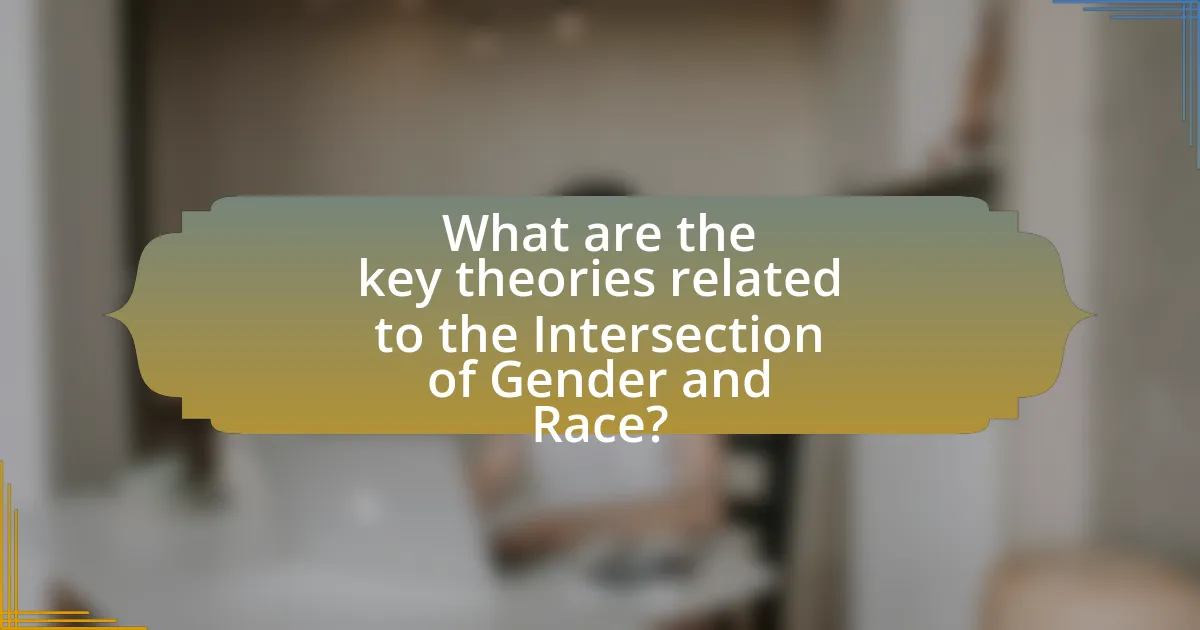
What are the key theories related to the Intersection of Gender and Race?
Key theories related to the intersection of gender and race include intersectionality, critical race theory, and Black feminist thought. Intersectionality, coined by Kimberlé Crenshaw, posits that social identities such as race and gender intersect to create unique experiences of oppression and privilege. Critical race theory examines how laws and social systems perpetuate racial inequalities, emphasizing the role of race in shaping gendered experiences. Black feminist thought, articulated by scholars like bell hooks and Patricia Hill Collins, highlights the specific challenges faced by Black women, arguing that their experiences cannot be understood solely through the lenses of race or gender but must consider the interplay of both. These theories collectively underscore the complexity of identity and the necessity of analyzing social issues through a multifaceted lens.
How do feminist theories address the intersection of gender and race?
Feminist theories address the intersection of gender and race by emphasizing how these two social categories interact to shape individual experiences and systemic inequalities. Intersectionality, a key concept introduced by Kimberlé Crenshaw, illustrates that the experiences of women of color cannot be fully understood by examining gender or race in isolation; rather, their identities are shaped by the overlapping effects of both. Research shows that women of color face unique challenges, such as higher rates of violence and economic disparity, which are not adequately addressed by mainstream feminist movements that often prioritize the experiences of white women. This intersectional approach highlights the necessity of inclusive frameworks that consider multiple identities and the specific contexts in which they operate, thereby enriching the understanding of social justice and advocacy efforts.
What are the main critiques of feminist theories regarding race?
The main critiques of feminist theories regarding race include their tendency to prioritize the experiences of white women, often neglecting the unique challenges faced by women of color. This critique is supported by scholars like Kimberlé Crenshaw, who introduced the concept of intersectionality, highlighting how race and gender intersect to create distinct forms of oppression that are overlooked in mainstream feminist discourse. Additionally, critics argue that traditional feminist frameworks often fail to address systemic racism and the historical context of colonialism, which disproportionately affects women of color. This oversight can lead to a homogenized understanding of women’s issues that does not reflect the diverse realities of all women.
How do intersectionality theories expand our understanding of gender and race?
Intersectionality theories expand our understanding of gender and race by highlighting how these identities intersect to create unique experiences of oppression and privilege. For instance, Kimberlé Crenshaw, who coined the term “intersectionality,” illustrated how Black women face discrimination that is not solely based on race or gender but on the combination of both, leading to distinct social challenges. Research shows that women of color often experience higher rates of violence and economic disadvantage compared to their white counterparts, emphasizing the need to consider multiple identities in social justice efforts. This framework allows for a more nuanced analysis of systemic inequalities, revealing how policies and societal norms can disproportionately affect individuals based on their intersecting identities.
What role do historical figures play in shaping the discourse on gender and race?
Historical figures significantly influence the discourse on gender and race by serving as catalysts for social change and embodying the struggles and achievements of marginalized groups. For instance, figures like Sojourner Truth and Frederick Douglass articulated the interconnectedness of race and gender in their advocacy for abolition and women’s rights, highlighting how systemic oppression affects both African Americans and women. Their speeches and writings, such as Truth’s “Ain’t I a Woman?” and Douglass’s narratives, provided critical frameworks for understanding the complexities of identity and inequality. These historical contributions continue to inform contemporary discussions on intersectionality, illustrating how past movements shape current social justice efforts.
Who are some key historical figures that exemplify the intersection of gender and race?
Key historical figures that exemplify the intersection of gender and race include Sojourner Truth, a former enslaved woman who became a prominent abolitionist and women’s rights activist, and Angela Davis, an African American political activist and scholar who played a significant role in the civil rights movement. Sojourner Truth delivered the famous “Ain’t I a Woman?” speech in 1851, highlighting the struggles faced by Black women. Angela Davis, active in the 1960s and 1970s, focused on issues of race, gender, and class, advocating for prison reform and social justice. Both figures illustrate how race and gender intersect in the fight for equality and justice.
What contributions have these figures made to social movements?
These figures have significantly advanced social movements by advocating for the rights and representation of marginalized groups. For instance, leaders like Sojourner Truth and Ida B. Wells highlighted the intersectionality of race and gender, emphasizing that the struggles of Black women were often overlooked in both feminist and civil rights movements. Their activism led to greater awareness and inclusion of these issues within broader social movements, as evidenced by Truth’s “Ain’t I a Woman?” speech in 1851 and Wells’ anti-lynching campaigns in the 1890s, which mobilized public opinion and influenced policy changes. These contributions laid foundational frameworks for contemporary discussions on intersectionality in social justice movements.
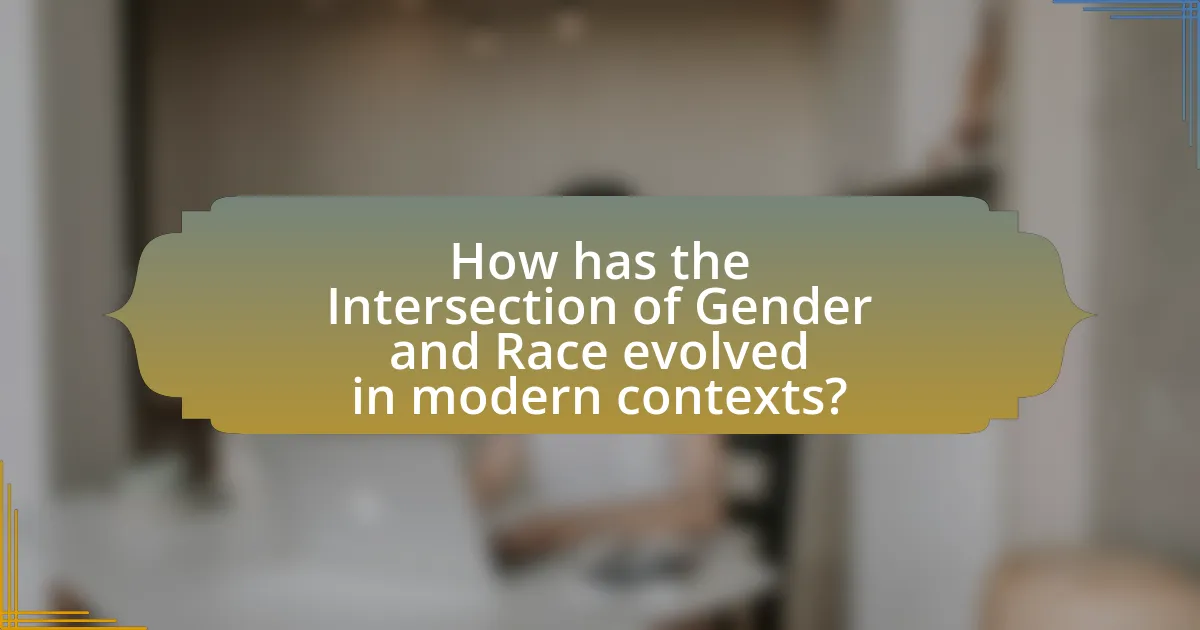
How has the Intersection of Gender and Race evolved in modern contexts?
The intersection of gender and race has evolved significantly in modern contexts, reflecting increased awareness and activism surrounding systemic inequalities. Contemporary movements, such as Black Lives Matter and #MeToo, highlight how race and gender intersect to shape experiences of discrimination and violence, particularly for women of color. Research indicates that women of color face unique challenges, as evidenced by the 2017 report from the Institute for Women’s Policy Research, which found that Black women earn only 63 cents for every dollar earned by white, non-Hispanic men, illustrating the compounded effects of racial and gender disparities in the workforce. Additionally, academic studies, such as those published in the Journal of Gender Studies, reveal that intersectionality is crucial for understanding the complexities of identity and social justice, emphasizing the need for inclusive policies that address both race and gender simultaneously.
What contemporary issues reflect the intersection of gender and race?
Contemporary issues that reflect the intersection of gender and race include systemic racism in healthcare, wage gaps, and representation in media and politics. For instance, Black women in the United States face a higher maternal mortality rate compared to white women, highlighting disparities in healthcare access and treatment. Additionally, the gender pay gap is exacerbated for women of color, with Black women earning approximately 63 cents and Latina women earning about 55 cents for every dollar earned by white, non-Hispanic men. Furthermore, representation in media and politics remains skewed, as women of color are often underrepresented in leadership roles, affecting policy decisions that impact their communities. These issues illustrate how gender and race intersect to create unique challenges for marginalized groups.
How do current social movements address the intersection of gender and race?
Current social movements address the intersection of gender and race by advocating for policies and practices that recognize and combat the unique challenges faced by individuals at this intersection. For instance, movements like Black Lives Matter and #MeToo highlight how systemic racism and sexism overlap, emphasizing the need for inclusive policies that address both racial and gender inequalities. Research shows that women of color experience higher rates of violence and discrimination, which these movements aim to bring to the forefront of social justice discussions. By centering the voices of marginalized groups, current social movements strive to create a more equitable society that acknowledges and addresses the complexities of identity.
What challenges remain in addressing the intersection of gender and race today?
Challenges in addressing the intersection of gender and race today include systemic discrimination, economic inequality, and social stigmatization. Systemic discrimination manifests in various institutions, such as the criminal justice system, where women of color face higher rates of incarceration compared to their white counterparts. Economic inequality is evident in wage gaps; for instance, Black women earn approximately 63 cents for every dollar earned by white men, highlighting persistent disparities in income. Social stigmatization further complicates these issues, as stereotypes and biases against women of color can lead to marginalization in both professional and personal spheres. These challenges are compounded by a lack of intersectional policies that adequately address the unique experiences of individuals at this intersection, making it difficult to achieve equity and justice.
What strategies can be employed to address the intersection of gender and race?
To address the intersection of gender and race, strategies must include intersectional policy-making, targeted educational programs, and community engagement initiatives. Intersectional policy-making involves creating laws and regulations that specifically consider how gender and race interact, ensuring that marginalized groups receive equitable treatment. For instance, the implementation of affirmative action policies has been shown to improve opportunities for women of color in education and employment, as evidenced by studies from the National Bureau of Economic Research, which highlight the positive impact of such policies on reducing disparities.
Targeted educational programs can raise awareness about the unique challenges faced by individuals at this intersection, fostering understanding and empathy. Research from the American Psychological Association indicates that educational interventions that address both gender and racial biases can significantly reduce prejudice and promote inclusivity.
Community engagement initiatives, such as grassroots organizing and coalition-building, empower individuals to advocate for their rights and influence local policies. The success of organizations like Black Women’s Blueprint demonstrates the effectiveness of community-led efforts in addressing systemic inequalities related to both gender and race. These strategies collectively contribute to a more equitable society by recognizing and addressing the complexities of intersecting identities.
How can education play a role in addressing these intersections?
Education can play a crucial role in addressing the intersections of gender and race by fostering awareness and understanding of these complex social dynamics. By integrating curricula that highlight the historical and contemporary experiences of marginalized groups, education can challenge stereotypes and promote critical thinking. For instance, studies show that inclusive educational practices improve empathy and reduce prejudice among students, as evidenced by research from the American Psychological Association, which found that diverse educational environments lead to better social outcomes. This approach not only equips students with knowledge but also encourages them to engage in social justice initiatives, thereby actively contributing to the dismantling of systemic inequalities related to gender and race.
What community initiatives have been successful in promoting awareness of gender and race intersections?
Community initiatives such as the “Black Women’s Blueprint” and “The Women’s March” have successfully promoted awareness of gender and race intersections. The Black Women’s Blueprint focuses on the unique challenges faced by Black women, advocating for policy changes and community support, while the Women’s March has highlighted issues of intersectionality, bringing together diverse groups to address systemic inequalities. Both initiatives have utilized social media campaigns and community events to engage a wider audience, demonstrating their effectiveness in raising awareness and fostering dialogue around these critical intersections.
What resources are available for further exploration of the Intersection of Gender and Race?
Resources for further exploration of the intersection of gender and race include academic journals, books, and online databases. Notable academic journals such as “Gender & Society” and “Journal of Race, Ethnicity, and Politics” publish peer-reviewed articles that analyze the complexities of gender and race interactions. Books like “Sister Outsider” by Audre Lorde and “Righteous Discontent” by Evelyn Brooks Higginbotham provide critical insights into the historical context of these intersections. Additionally, online databases such as JSTOR and Google Scholar offer access to a wide range of scholarly articles and research papers focused on gender and race studies, facilitating deeper understanding and exploration of the topic.
Which books and articles provide in-depth analysis of this intersection?
Books and articles that provide in-depth analysis of the intersection of gender and race in historical contexts include “Sister Outsider” by Audre Lorde, which explores the complexities of identity and oppression, and “Race, Gender, and Class in Media” edited by Gail Dines and Jean M. Humez, which examines how media representations shape societal perceptions of race and gender. Additionally, “Black Feminist Thought” by Patricia Hill Collins offers critical insights into the experiences of Black women, emphasizing the interconnectedness of race, gender, and class. These works are foundational in understanding the nuanced dynamics at this intersection, supported by extensive research and historical examples.
What organizations focus on the intersection of gender and race in their work?
Organizations that focus on the intersection of gender and race include the National Organization for Women (NOW), the Black Women’s Blueprint, and the Asian Pacific American Labor Alliance (APALA). These organizations address issues that affect women of color, advocating for policies and practices that consider both gender and racial inequalities. For instance, the Black Women’s Blueprint works specifically to uplift the voices and experiences of Black women, while NOW campaigns for equal rights across various demographics, emphasizing the need for intersectional approaches in feminist movements. APALA focuses on labor rights for Asian Pacific Americans, highlighting the unique challenges faced by this demographic in the workforce.
